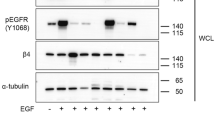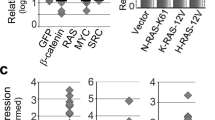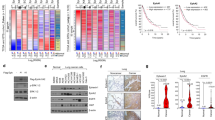Abstract
Tyrosine kinase receptors have an essential role in various aspects of tumor progression. In particular, epidermal growth factor receptor (EGFR) and its ligands have been implicated in the growth and dissemination of a wide array of human carcinomas. Here, we describe an EGFR-mediated signaling pathway that regulates human pancreatic carcinoma cell invasion and metastasis, yet does not influence the growth of primary tumors. In fact, ligation/activation of EGFR induces Src-dependent phosphorylation of two critical tyrosine residues of p130CAS, leading to the assembly of a Crk-associated substrate (CAS)/Nck1 complex that promotes Ras-associated protein-1 (Rap1) signaling. Importantly, GTP loading of Rap1 is specifically required for pancreatic carcinoma cell migration on vitronectin but not on collagen. Furthermore, Rap1 activation is required for EGFR-mediated metastasis in vivo without impacting primary tumor growth. These findings identify a molecular pathway that promotes the invasive/metastatic properties of human pancreatic carcinomas driven by EGFR.
This is a preview of subscription content, access via your institution
Access options
Subscribe to this journal
Receive 50 print issues and online access
$259.00 per year
only $5.18 per issue
Buy this article
- Purchase on Springer Link
- Instant access to full article PDF
Prices may be subject to local taxes which are calculated during checkout





Similar content being viewed by others
References
Bailey CL, Kelly P, Casey PJ . (2009). Activation of Rap1 promotes prostate cancer metastasis. Cancer Res 69: 4962–4968.
Bos JL . (2005). Linking Rap to cell adhesion. Curr Opin Cell Biol 17: 123–128.
Brabek J, Constancio SS, Shin NY, Pozzi A, Weaver AM, Hanks SK . (2004). CAS promotes invasiveness of Src-transformed cells. Oncogene 23: 7406–7415.
Brabek J, Constancio SS, Siesser PF, Shin NY, Pozzi A, Hanks SK . (2005). Crk-associated substrate tyrosine phosphorylation sites are critical for invasion and metastasis of Src-transformed cells. Mol Cancer Res 3: 307–315.
Brooks PC, Klemke RL, Schon S, Lewis JM, Schwartz MA, Cheresh DA . (1997). Insulin-like growth factor receptor cooperates with integrin alpha v beta 5 to promote tumor cell dissemination in vivo. J Clin Invest 99: 1390–1398.
Bruns CJ, Solorzano CC, Harbison MT, Ozawa S, Tsan R, Fan D et al. (2000). Blockade of the epidermal growth factor receptor signaling by a novel tyrosine kinase inhibitor leads to apoptosis of endothelial cells and therapy of human pancreatic carcinoma. Cancer Res 60: 2926–2935.
Cheresh DA, Leng J, Klemke RL . (1999). Regulation of cell contraction and membrane ruffling by distinct signals in migratory cells. J Cell Biol 146: 1107–1116.
Faller BA, Burtness B . (2009). Treatment of pancreatic cancer with epidermal growth factor receptor-targeted therapy. Biologics 3: 419–428.
Frische EW, Zwartkruis FJ . (2010). Rap1, a mercenary among the Ras-like GTPases. Dev Biol 340: 1–9.
Furstenau DK, Mitra N, Wan F, Lewis R, Feldman MD, Fraker DL et al. (2010). Ras-related protein 1 and the insulin-like growth factor type I receptor are associated with risk of progression in patients diagnosed with carcinoma in situ. Breast Cancer Res Treat 129: 361–372.
Gao L, Feng Y, Bowers R, Becker-Hapak M, Gardner J, Council L et al. (2006). Ras-associated protein-1 regulates extracellular signal-regulated kinase activation and migration in melanoma cells: two processes important to melanoma tumorigenesis and metastasis. Cancer Res 66: 7880–7888.
Goldberg GS, Alexander DB, Pellicena P, Zhang ZY, Tsuda H, Miller WT . (2003). Src phosphorylates Cas on tyrosine 253 to promote migration of transformed cells. J Biol Chem 278: 46533–46540.
Gu J, Sumida Y, Sanzen N, Sekiguchi K . (2001). Laminin-10/11 and fibronectin differentially regulate integrin-dependent Rho and Rac activation via p130(Cas)–CrkII–DOCK180 pathway. J Biol Chem 276: 27090–27097.
Guix M, Faber AC, Wang SE, Olivares MG, Song Y, Qu S et al. (2008). Acquired resistance to EGFR tyrosine kinase inhibitors in cancer cells is mediated by loss of IGF binding proteins. J Clin Invest 118: 2609–2619.
Huang J, Hamasaki H, Nakamoto T, Honda H, Hirai H, Saito M et al. (2002). Differential regulation of cell migration, actin stress fiber organization, and cell transformation by functional domains of Crk-associated substrate. J Biol Chem 277: 27265–27272.
Jenei V, Andersson T, Jakus J, Dib K . (2005). E3B1, a human homologue of the mouse gene product Abi-1, sensitizes activation of Rap1 in response to epidermal growth factor. Exp cell Res 310: 463–473.
Kim H, Muller WJ . (1999). The role of the epidermal growth factor receptor family in mammary tumorigenesis and metastasis. Exp cell Res 253: 78–87.
Klemke RL, Leng J, Molander R, Brooks PC, Vuori K, Cheresh DA . (1998). CAS/Crk coupling serves as a ‘molecular switch’ for induction of cell migration. J Cell Biol 140: 961–972.
Klemke RL, Yebra M, Bayna EM, Cheresh DA . (1994). Receptor tyrosine kinase signaling required for integrin alpha v beta 5-directed cell motility but not adhesion on vitronectin. J Cell Biol 127: 859–866.
Lotz M, Wang HH, Cance W, Matthews J, Pories S . (2003). Epidermal growth factor stimulation can substitute for c-Src overexpression in promoting breast carcinoma invasion. J Surg Res 109: 123–129.
Lu Z, Ghosh S, Wang Z, Hunter T . (2003). Downregulation of caveolin-1 function by EGF leads to the loss of E-cadherin, increased transcriptional activity of beta-catenin, and enhanced tumor cell invasion. Cancer Cell 4: 499–515.
Matsumoto S, Takahashi K, Iwakawa R, Matsuno Y, Nakanishi Y, Kohno T et al. (2006). Frequent EGFR mutations in brain metastases of lung adenocarcinoma. Int J Cancer 119: 1491–1494.
Mitra RS, Goto M, Lee JS, Maldonado D, Taylor JM, Pan Q et al. (2008). Rap1GAP promotes invasion via induction of matrix metalloproteinase 9 secretion, which is associated with poor survival in low N-stage squamous cell carcinoma. Cancer Res 68: 3959–3969.
Mochizuki N, Yamashita S, Kurokawa K, Ohba Y, Nagai T, Miyawaki A et al. (2001). Spatio-temporal images of growth-factor-induced activation of Ras and Rap1. Nature 411: 1065–1068.
Morgan MA, Parsels LA, Kollar LE, Normolle DP, Maybaum J, Lawrence TS . (2008). The combination of epidermal growth factor receptor inhibitors with gemcitabine and radiation in pancreatic cancer. Clin Cancer Res 14: 5142–5149.
Morgillo F, Woo JK, Kim ES, Hong WK, Lee HY . (2006). Heterodimerization of insulin-like growth factor receptor/epidermal growth factor receptor and induction of survivin expression counteract the antitumor action of erlotinib. Cancer Res 66: 10100–10111.
Ohba Y, Kurokawa K, Matsuda M . (2003). Mechanism of the spatio-temporal regulation of Ras and Rap1. EMBO J 22: 859–869.
Papouchado B, Erickson LA, Rohlinger AL, Hobday TJ, Erlichman C, Ames MM et al. (2005). Epidermal growth factor receptor and activated epidermal growth factor receptor expression in gastrointestinal carcinoids and pancreatic endocrine carcinomas. Mod Pathol 18: 1329–1335.
Payne SL, Hendrix MJ, Kirschmann DA . (2006). Lysyl oxidase regulates actin filament formation through the p130(Cas)/Crk/DOCK180 signaling complex. J Cell Biochem 98: 827–837.
Peace BE, Hill KJ, Degen SJ, Waltz SE . (2003). Cross-talk between the receptor tyrosine kinases Ron and epidermal growth factor receptor. Exp Cell Res 289: 317–325.
Pryczynicz A, Guzińska-Ustymowicz K, Kemona A, Czyzewska J . (2008). Expression of EGF and EGFR strongly correlates with metastasis of pancreatic ductal carcinoma. Anticancer Res 28: 1399–1404.
Retta SF, Balzac F, Avolio M . (2006). Rap1: a turnabout for the crosstalk between cadherins and integrins. Eur J Cell Biol 85: 283–293.
Ricono JM, Huang M, Barnes LA, Lau SK, Weis SM, Schlaepfer DD et al. (2009). Specific cross-talk between epidermal growth factor receptor and integrin alphavbeta5 promotes carcinoma cell invasion and metastasis. Cancer Res 69: 1383–1391.
Rivera F, Lopez-Tarruella S, Vega-Villegas ME, Salcedo M . (2009). Treatment of advanced pancreatic cancer: from gemcitabine single agent to combinations and targeted therapy. Cancer Treat Rev 35: 335–339.
Rivera GM, Antoku S, Gelkop S, Shin NY, Hanks SK, Pawson T et al. (2006). Requirement of Nck adaptors for actin dynamics and cell migration stimulated by platelet-derived growth factor B. Proc Natl Acad Sci USA 103: 9536–9541.
Sakakibara A, Ohba Y, Kurokawa K, Matsuda M, Hattori S . (2002). Novel function of Chat in controlling cell adhesion via Cas–Crk–C3G-pathway-mediated Rap1 activation. J Cell Sci 115: 4915–4924.
Schlaepfer DD, Broome MA, Hunter T . (1997). Fibronectin-stimulated signaling from a focal adhesion kinase-c–Src complex: involvement of the Grb2, p130cas, and Nck adaptor proteins. Mol Cell Biol 17: 1702–1713.
Shattil SJ, Kim C, Ginsberg MH . (2010). The final steps of integrin activation: the end game. Mol Cell Biol 11: 288–300.
Shimonaka M, Katagiri K, Nakayama T, Fujita N, Tsuruo T, Yoshie O et al. (2003). Rap1 translates chemokine signals to integrin activation, cell polarization, and motility across vascular endothelium under flow. J Cell Biol 161: 417–427.
Shin NY, Dise RS, Schneider-Mergener J, Ritchie MD, Kilkenny DM, Hanks SK . (2004). Subsets of the major tyrosine phosphorylation sites in Crk-associated substrate (CAS) are sufficient to promote cell migration. J Biol Chem 279: 38331–38337.
Summy JM, Gallick GE . (2003). Src family kinases in tumor progression and metastasis. Cancer Metastasis Rev 22: 337–358.
Tamada M, Sheetz MP, Sawada Y . (2004). Activation of a signaling cascade by cytoskeleton stretch. Dev Cell 7: 709–718.
Thomas RM, Toney K, Fenoglio-Preiser C, Revelo-Penafiel MP, Hingorani SR, Tuveson DA et al. (2007). The RON receptor tyrosine kinase mediates oncogenic phenotypes in pancreatic cancer cells and is increasingly expressed during pancreatic cancer progression. Cancer Res 67: 6075–6082.
Trevino JG, Summy JM, Lesslie DP, Parikh NU, Hong DS, Lee FY et al. (2006). Inhibition of SRC expression and activity inhibits tumor progression and metastasis of human pancreatic adenocarcinoma cells in an orthotopic nude mouse model. Am J Pathol 168: 962–972.
Tsygankova OM, Ma C, Tang W, Korch C, Feldman MD, Lv Y et al. (2010). Downregulation of Rap1GAP in human tumor cells alters cell/matrix and cell/cell adhesion. Mol Cell Biol 30: 3262–3274.
Tsygankova OM, Prendergast GV, Puttaswamy K, Wang Y, Feldman MD, Wang H et al. (2007). Downregulation of Rap1GAP contributes to Ras transformation. Mol Cell Biol 27: 6647–6658.
Ueno Y, Sakurai H, Tsunoda S, Choo MK, Matsuo M, Koizumi K et al. (2008). Heregulin-induced activation of ErbB3 by EGFR tyrosine kinase activity promotes tumor growth and metastasis in melanoma cells. Int J Cancer 123: 340–347.
Wolpin BM, Michaud DS, Giovannucci EL, Schernhammer ES, Stampfer MJ, Manson JE et al. (2007). Circulating insulin-like growth factor binding protein-1 and the risk of pancreatic cancer. Cancer Res 67: 7923–7928.
Xu J, Shi S, Matsumoto N, Noda M, Kitayama H . (2007). Identification of Rgl3 as a potential binding partner for Rap-family small G-proteins and profilin II. Cell Signal 19: 1575–1582.
Yaman E, Gasper R, Koerner C, Wittinghofer A, Tazebay UH . (2009). RasGEF1A and RasGEF1B are guanine nucleotide exchange factors that discriminate between Rap GTP-binding proteins and mediate Rap2-specific nucleotide exchange. FEBS J 276: 4607–4616.
Zhang L, Chenwei L, Mahmood R, Van Golen K, Greenson J, Li G et al. (2006). Identification of a putative tumor suppressor gene Rap1GAP in pancreatic cancer. Cancer Res 66: 898–906.
Acknowledgements
We thank Dr Steven K Hanks for the donation of the CAS mutant plasmids and Dr David J Shields for helpful discussion. This work was supported by NIH Grants CA107263 (DGS), HL56595 and HL47900 (SJS), CA102310 (DDS), and CA045726 (DAC).
Author information
Authors and Affiliations
Corresponding author
Ethics declarations
Competing interests
The authors declare no conflict of interest.
Additional information
Supplementary Information accompanies the paper on the Oncogene website
Rights and permissions
About this article
Cite this article
Huang, M., Anand, S., Murphy, E. et al. EGFR-dependent pancreatic carcinoma cell metastasis through Rap1 activation. Oncogene 31, 2783–2793 (2012). https://doi.org/10.1038/onc.2011.450
Received:
Revised:
Accepted:
Published:
Issue Date:
DOI: https://doi.org/10.1038/onc.2011.450
Keywords
This article is cited by
-
STAT3-induced NCK1 elevation promotes migration of triple-negative breast cancer cells via regulating ERK1/2 signaling
Molecular Biology Reports (2022)
-
Characterization of evolution trajectory and immune profiling of brain metastasis in lung adenocarcinoma
npj Precision Oncology (2021)
-
Nck1 promotes the progression of ovarian carcinoma by enhancing the PI3K/AKT/p70S6K signaling
Human Cell (2020)
-
Long noncoding RNA LINC00460 aggravates invasion and metastasis by targeting miR-30a-3p/Rap1A in nasopharyngeal carcinoma
Human Cell (2019)
-
Integrins as therapeutic targets in the organ-specific metastasis of human malignant melanoma
Journal of Experimental & Clinical Cancer Research (2018)



